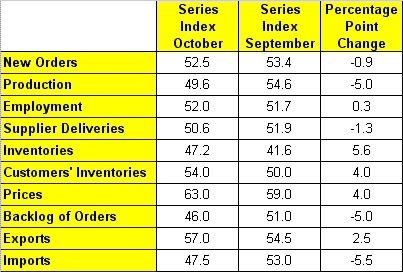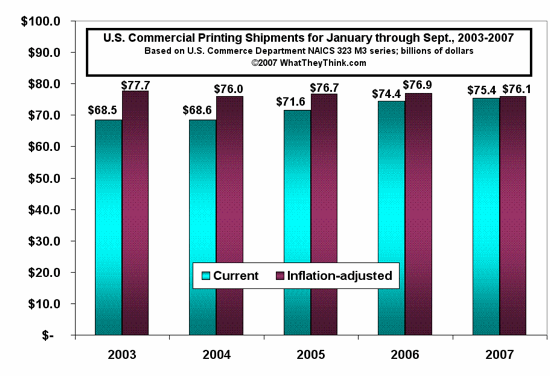If You Think the Economic Data Conflicted Before, Just Look at the Mess They're In Now!
The very upbeat third-quarter GDP report surprised the experts and gave the U.S. economy two consecutive very strong quarters. This was despite housing and subprime woes and any other negativity you could throw at it. The personal income report indicated some slowing, but it was still rather good, and the unemployment report showed a robust 166,000 gain in payrolls.
Nonetheless, the economy appears to be at a turning point in my mind. The Fed lowered interest rates again, and stating, "the pace of economic expansion will likely slow in the near term..." The statement also said that the move "...should help forestall some of the adverse effects on the broader economy that might otherwise arise..." in relation to the various subprime and housing issues.
I have rather strong feelings that the dollar's continuing weakness will be intensified by this rate cut, and because of it we're on our way to $110 oil while the rest of the world is seeing constant prices. Though U.S. exports will be aided by a yet weaker dollar, that's small comfort because exports have been good for the last few years anyway. In many ways, imports and exports are less elastic than they were in the past, especially when multinational companies are involved. When you have transactions on both sides of the exchange rate, these kinds of issues are easier to manage and exchange rate changes do not affect these multinationals the way they did before.
Still, these oil prices when adjusted for inflation and energy productivity are not yet close to oil embargo prices (they'd have to almost double from these levels), but they do weigh on the consumer's psyche, especially when played up in the media (who only rarely adjust for inflation or productivity). In the short term, consumers can have difficulty sorting through their economic alternatives to compensate for these prices.
My primary concern this week was the ISM Manufacturing Index. While the top level of the report showed continued growth in manufacturing, the subcomponents of the index were worrying. Remember, any number above 50 implies growth. The overall ISM index was 50.9, and that was down from 52.0 the month prior. The only bright spots in the chart below below are employment and exports.

Production is now contracting. Inventories are contracting, and customer inventories are rising, which means that they are having trouble selling their goods. Inventory problems are being accompanied by a decline in the backlog of orders, which implies that the production declines will persist. Imports are decreasing, which means that orders for the ingredients of many products are being reduced. Prices paid for materials are up. These often have to be balanced by raising customer prices or adjusting costs and expenses elsewhere, with moves such as workforce reductions.
The unemployment report was only good on the surface. The household survey, which includes self-employment, was down -250,000. It's been down four of the last six months. This is important because the payroll survey generally lags the economy by about six months, and the household survey, on which the unemployment rate is based, is more "real time."
Companies in the transportation industry are complaining that loads are down considerably from last year, and that retailers are not stocking up for the holiday season they way they did last year. They have been vocal about getting the Fed to cut rates yet more; the way they see it, the economy is in a slowdown.
The Fed should not have lowered rates; rates were low already, and the Fed's half point move of about a month ago was still working its way through the economy. The Fed could have held things where they were, and told the markets, especially the banking industry, that what they wanted in terms of lower rates was not what they needed, which was to sort through their own problems and be disciplined in lending.
Lower rates reduce the potential for collateral damage outside of the banking industry, but they will only serve to create more insidious damage with higher inflation and a weaker economy for the next year. There is a time when lower rates are a cure for a slowing economy. This is not one of those times, not when GDP is still strong, employment is at better than full employment. The added dollars from the Fed action will not be countered by an increase in the output of goods. The additional dollars will just become inflation.
Rather, this is a time for tax cuts that stimulate investment and lower costs by increasing productivity, just as many emerging market countries have done. We're not getting reductions any time soon, and may not get them for years; the tax rates in effect now are the lowest that will be seen for quite some time. Plan accordingly.
The Fed can't change tax rates, of course, but adding more liquidity now is not the right prescription as those dollars will go to all of the wrong places. Hold onto your hats. This could get unnecessarily exciting to the downside.
Printing Shipments
September printing shipments were up +$55 million in current dollars compared to September 2006. On an inflation adjusted basis, however, they were down -$188 million, a -2% decline. Interestingly, the inflation-adjusted data are the best estimation we have for judging physical volume of printing by U.S. commercial shops.
August's original shipments data were revised by +$24 million to nearly $8.8 billion in current dollars.
For the first nine months of 2007, we are up +$1 billion on a current dollar basis, but down -$800 million on a real basis. The last eight months of real data have been negative compared to 2006.
September, October, and November are traditionally the strongest and most important three months in the commercial printing year. The employment data released on Friday, which we will discuss in more detail next week, show that there were 3,000 fewer printing production employees in October 2007 compared to October 2006. This implies that October's shipments will be down as compared to 2006.

While we're here, if printing tracks GDP, and GDP had two really strong quarters at almost +4% real growth, why was real growth in print volume negative for that period? Old rules of thumb, like habits, are very hard to break.
Industry Education Needs Our Support
I have written about this topic and addressed it quite often as various industry trends or changes affect it. (Last year's "Do We Really Need Graphic Communications Education?" still reflects my thoughts). What is it that is the real driver for graphic arts education? Simple: the need for skills that add value for printing clients.
Though some industry data show that employment has been declining and wages have been, at best, stagnant, that does not mean that we do not need employees. Skills are changing, and job requirements change to reflect economic and technological considerations all the time. High paying prepress jobs have long shifted over to design and other media production in other industries, and that is understandably the focus of many graphics programs. It's a lot easier to teach desktop publishing in a classroom than to teach press operation. Many pressroom jobs go unfilled because of that, and because of the decline of the "union school" in many large cities. Add to that that printing is not normally considered a sexy or glitzy career, whereas web design may hold more appeal for today's younger generation.
It's easy to lament the situation, but there is a greater truth here that needs to be expressed, however obvious it may seem. Growing, profitable companies attract workers. That's companies and not industries. Workers who are pleased with their jobs tell others in their families and in their circle of friends and acquaintances. An inviting workplace is essential in job satisfaction and employee retention, but also to attract new employees.
We also forget that the idea of running one's own business has been a major why many joined the printing industry for decades, perhaps centuries. Want more workers? Get more owners. This is one area where franchise operations have been so critical to our industry over the years, inviting non-graphic investors into our industry.
And what of the non-graphic workers? There is a great emphasis on graphic arts education in our industry, but I find far more people without graphic degrees running businesses or in important executive positions. We need accountants, personnel managers, maintenance and equipment workers, computer networking experts, shipping and receiving workers, and many others. What is it that we do to interest them?
Sometimes it seems that we are looking for young 20-somethings, enthusiastic graphic graduates but with twenty years of industry experience. Today, it's often harder to find jobs where one can get experience. What is it that your company is doing to cultivate and train young talent?
There are a variety of actions that can certainly improve our situation and make the industry more attractive to students looking for an interesting and rewarding career.
First, we need to support our graphic communications programs wherever they may be. Sometimes it's time or money or both, but there are other things we can do. Have graphic arts teachers visit your shop, perhaps with students, on a casual basis. Let them see how a shop works, the kinds of equipment that's around, and also get to know the other workers. That not only adds a valuable educational element, but gives students the opportunity to hear firsthand how much others love this industry.
Second, we need to nurture graphic communications programs to make certain they are as current as possible. Many schools cannot afford the latest equipment, and do not have the room for it even if they could. Consider offering to host a course in your shop. Promote field trips to see shops in operation and encourage employees to participate. And for the vendors out there, especially software, be aggressive in donating your software for educational use. Not only does it help the graphic communications programs, but—selfishly—it gives students experience with your product as they head out into the marketplace. That approach certainly worked for Apple.
Third, we need to support the students. Get interns involved in your business. Our industry is one of the few where you can be a worker and get to know "the boss" and "the entrepreneur" as co-workers.
Fourth, get to know high school guidance counselors in your area personally. In fact, it might be a good idea to work through your local chamber of commerce to establish a multi-industry initiative designed to help counselors get a better idea of the kinds of workers who are needed in the local area. Very often they are working with national reports and data that do not mirror the needs of the communities in which they work.
Fifth, desktop publishing and web design should be positioned, from a marketing perspective, as low level jobs. "If you really want to see what communications technology is like," we should say, "take a look at what's going on in the printing industry." This is not that much of a marketing stretch. The kinds of technologies involved in our production systems and digital printing could be conceivably be promoted as a step up, if we decide to do so. But we have to believe it first.
Finally, make a real effort to creating a workplace that encourages people to recommend the graphic arts as a career. I'm still asked if I would tell my son to enter the industry. I certainly would, if his interests are in this direction (currently they're aiming at the aviation industry). It's his choice, of course, and I wouldn't force it on him, but his computer networking and communications experience make him a natural fit for a progressive shop. There are many opportunities and many roles available in an industry as dynamic and changing as ours. Keeping them secret doesn't help anyone.










